curiositytherover
299 posts
Latest Posts by curiositytherover
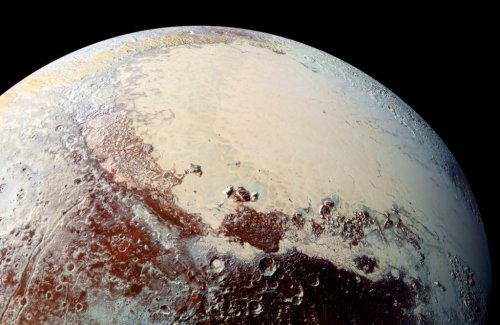
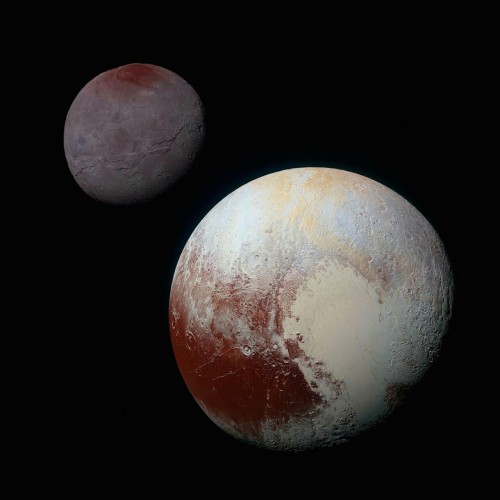
latest photos of Pluto and it’s moon.

In parts of Antarctica, not only is it winter, but the Sun can spend weeks below the horizon.At China's Zhongshan Station, people sometimes venture out into the cold to photograph a spectacular night sky.The featured image from one such outing was taken in mid-July, just before the end of this polar night.Pointing up, the wide angle lens captured not only the ground at the bottom, but at the top as well. In the foreground is a colleague also taking pictures.In the distance, a spherical satellite receiver and several windmills are visible.Numerous stars dot the night sky, including Sirius and Canopus.Far in the background, stretching overhead from horizon to horizon, is the central band of our Milky Way Galaxy.Even further in the distance, visible as extended smudges near the top, are the Large and Small Magellanic Clouds, satellite galaxies near our huge Milky Way Galaxy.
Credit: NASA
Time And Space
Solar System: Things to Know This Week
This week, we’re looking at MAVEN’s exploration of Mars, the Orionid meteor showers, Mercury’s “great valley” and more.

1. Celebrating MAVEN
MAVEN, the Mars Atmospheric and Volatile Evolution, was the second mission selected for our Mars Scout program and the first to explore the planet’s upper atmosphere . It launched on November 18, 2013 and entered orbit around Mars on September 21, 2014.
+ MAVEN Quick Facts

2. Jupiter Moon Dance
This time-lapse sequence of Hubble Space Telescope images shows Jupiter’s moon Europa as it moved across the planet’s face over the course of 19 minutes. Europa is at the bottom center on Jupiter’s disk, the Great Red Spot to the left and Europa’s shadow to its right. The video was created by combining six snapshots taken in ultraviolet light with Hubble’s Wide Field Camera 3.
+ Learn more

3. The Orionid Meteor Shower
Orionid shower peaks November 28. Look for the constellation Orion in the Southeast sky by 9 p.m. Using binoculars, look for the Orion Nebula.

4. Comet Warming Up!!
Comet 45P/Honda-Mrkos-Pajdu áková will brighten to expected stunning binocular visibility in mid to late December, but is near Venus on November 23rd.
+ Track the Comet

5. Mercury’s “Great Valley”
A newly discovered “great valley” in the southern hemisphere of Mercury provides more evidence that the planet closest to the sun is shrinking. Using stereo images from our MESSENGER spacecraft to create a high-resolution map, scientists have discovered that revealed the broad valley – more than 620 miles (1,000 kilometers) long – extending into the Rembrandt basin, one of the largest and youngest impact basins on Mercury. About 250 miles (400 kilometers) wide and 2 miles (3 kilometers) deep, Mercury’s great valley is smaller than Mars’ Valles Marineris, but larger than North America’s Grand Canyon and wider and deeper than the Great Rift Valley in East Africa.
+ Learn more
Discover the full list of 10 things to know about our solar system this week HERE.
Make sure to follow us on Tumblr for your regular dose of space: http://nasa.tumblr.com

A man in Sweden accidentally captured this image of a green meteorite while taking pictures of the Northern lights.

One of the physicists who helped find the Higgs boson, Elina Berglund, has spent the past three years working on something completely different - a fertility app that tells women when they’re fertile or not.
It’s not the first fertility app out there, but Berglund’s app works so well that it’s been shown to help women avoid pregnancy with 99.5 percent reliability - an efficacy that puts it right up there with the pill and condoms.
Best of all, the app doesn’t have any side effects, and just requires women to input their temperature daily to map their fertility throughout the month.
Back in 2012, Berglund was working at CERN on the Large Hadron Collider experiment to find the famous Higgs boson. But after the discovery of the particle, she felt it was time to work on something completely different.
“I wanted to give my body a break from the pill,” she told Daniela Walker from Wired, “but I couldn’t find any good forms of natural birth control, so I wrote an algorithm for myself.”
The resulting app is called Natural Cycles, and so far, it’s had pretty promising results.
Continue Reading.
I never take selfies let alone smiling selfies and I’m hardly ever happy. Lemme see if this actually works
Saving lives on the road with virtual reality http://futurism.com/videos/saving-lives-on-the-road-with-virtual-reality/?utm_campaign=coschedule&utm_source=tumblr&utm_medium=futurismnews&utm_content=Saving%20lives%20on%20the%20road%20with%20virtual%20reality
Saving lives on the road with virtual reality
This virtual simulation is convincing drivers across the country of the dangers of distracted driving.

This Wristband Tells You Exactly What Vitamins You Need

This VR Film Puts You In The World Of A Blind Person
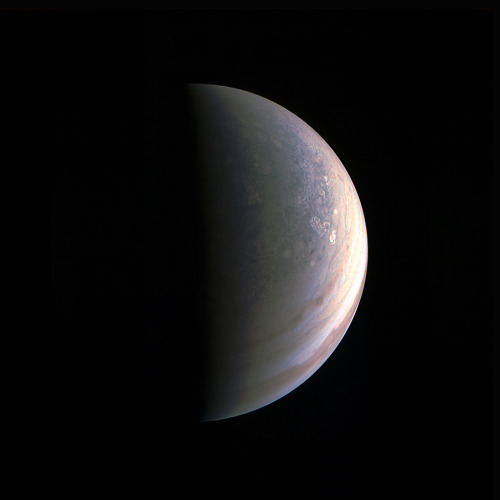
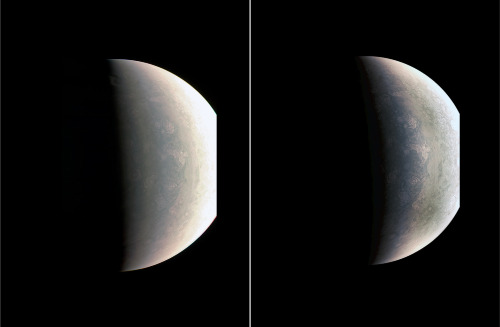
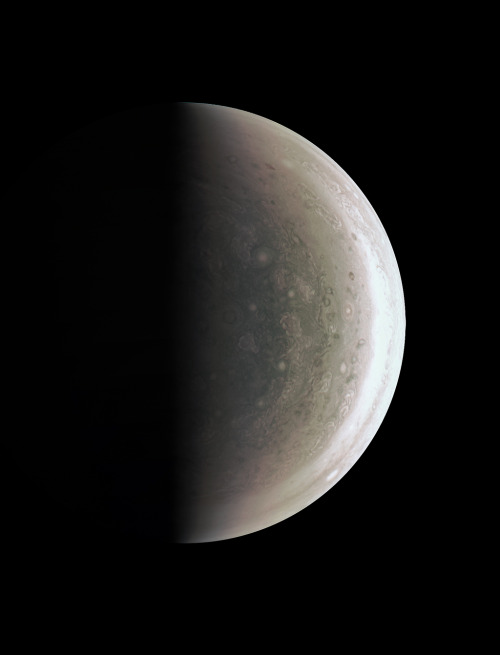
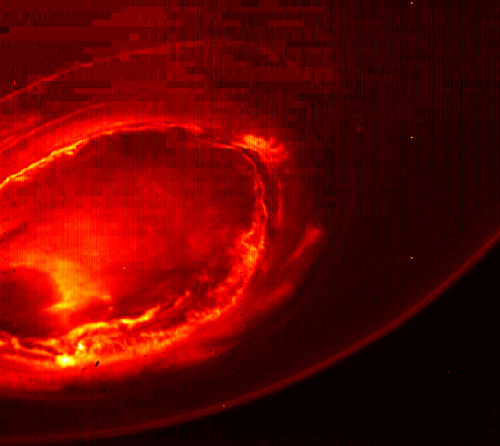
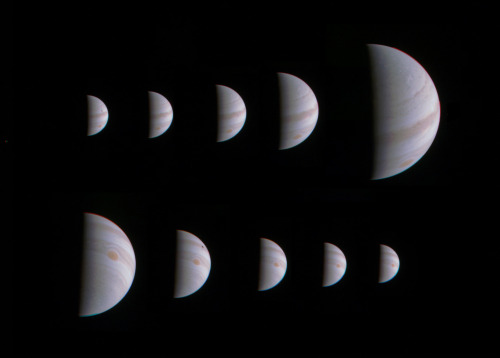
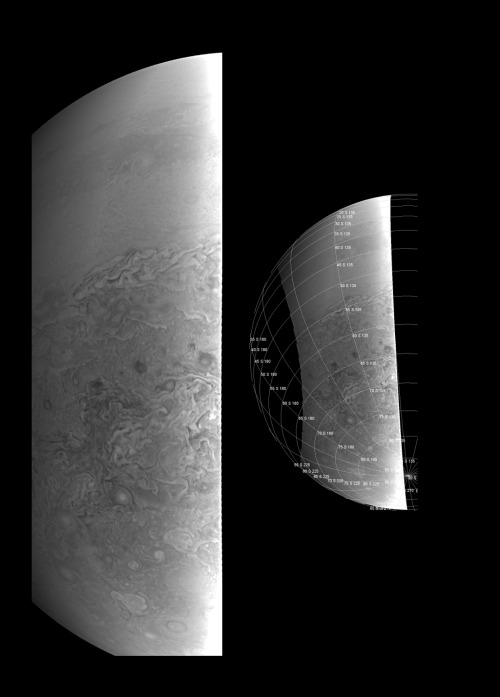
Jupiter’s North Pole Unlike Anything Encountered in Solar System
NASA’s Juno spacecraft has sent back the first-ever images of Jupiter’s north pole, taken during the spacecraft’s first flyby of the planet with its instruments switched on. The images show storm systems and weather activity unlike anything previously seen on any of our solar system’s gas-giant planets.
Juno successfully executed the first of 36 orbital flybys on Aug. 27 when the spacecraft came about 2,500 miles (4,200 kilometers) above Jupiter’s swirling clouds. The download of six megabytes of data collected during the six-hour transit, from above Jupiter’s north pole to below its south pole, took one-and-a-half days. While analysis of this first data collection is ongoing, some unique discoveries have already made themselves visible.
“First glimpse of Jupiter’s north pole, and it looks like nothing we have seen or imagined before,” said Scott Bolton, principal investigator of Juno from the Southwest Research Institute in San Antonio. “It’s bluer in color up there than other parts of the planet, and there are a lot of storms. There is no sign of the latitudinal bands or zone and belts that we are used to – this image is hardly recognizable as Jupiter. We’re seeing signs that the clouds have shadows, possibly indicating that the clouds are at a higher altitude than other features.”
One of the most notable findings of these first-ever pictures of Jupiter’s north and south poles is something that the JunoCam imager did not see.
“Saturn has a hexagon at the north pole,” said Bolton. “There is nothing on Jupiter that anywhere near resembles that. The largest planet in our solar system is truly unique. We have 36 more flybys to study just how unique it really is.”
Along with JunoCam snapping pictures during the flyby, all eight of Juno’s science instruments were energized and collecting data. The Jovian Infrared Auroral Mapper (JI-RAM), supplied by the Italian Space Agency, acquired some remarkable images of Jupiter at its north and south polar regions in infrared wavelengths.
“JIRAM is getting under Jupiter’s skin, giving us our first infrared close-ups of the planet,” said Alberto Adriani, JIRAM co-investigator from Istituto di Astrofisica e Planetologia Spaziali, Rome. “These first infrared views of Jupiter’s north and south poles are revealing warm and hot spots that have never been seen before. And while we knew that the first ever infrared views of Jupiter’s south pole could reveal the planet’s southern aurora, we were amazed to see it for the first time. No other instruments, both from Earth or space, have been able to see the southern aurora. Now, with JIRAM, we see that it appears to be very bright and well structured. The high level of detail in the images will tell us more about the aurora’s morphology and dynamics.”
Among the more unique data sets collected by Juno during its first scientific sweep by Jupiter was that acquired by the mission’s Radio/Plasma Wave Experiment (Waves), which recorded ghostly- sounding transmissions emanating from above the planet. These radio emissions from Jupiter have been known about since the 1950s but had never been analyzed from such a close vantage point.
“Jupiter is talking to us in a way only gas-giant worlds can,” said Bill Kurth, co-investigator for the Waves instrument from the University of Iowa, Iowa City. “Waves detected the signature emissions of the energetic particles that generate the massive auroras which encircle Jupiter’s north pole. These emissions are the strongest in the solar system. Now we are going to try to figure out where the electrons come from that are generating them.”
The Juno spacecraft launched on Aug. 5, 2011, from Cape Canaveral, Florida and arrived at Jupiter on July 4, 2016. JPL manages the Juno mission for the principal investigator, Scott Bolton, of Southwest Research Institute in San Antonio. Juno is part of NASA’s New Frontiers Program, which is managed at NASA’s Marshall Space Flight Center in Huntsville, Alabama, for NASA’s Science Mission Directorate. Lockheed Martin Space Systems, Denver, built the spacecraft. Caltech in Pasadena, California, manages JPL for NASA.
IMAGE 1….As NASA’s Juno spacecraft closed in on Jupiter for its Aug. 27, 2016 pass, its view grew sharper and fine details in the north polar region became increasingly visible. The JunoCam instrument obtained this view on August 27, about two hours before closest approach, when the spacecraft was 120,000 miles (195,000 kilometers) away from the giant planet (i.e., for Jupiter’s center). Unlike the equatorial region’s familiar structure of belts and zones, the poles are mottled with rotating storms of various sizes, similar to giant versions of terrestrial hurricanes. Jupiter’s poles have not been seen from this perspective since the Pioneer 11 spacecraft flew by the planet in 1974.
IMAGE 2….Storm systems and weather activity unlike anything encountered in the solar system are on view in these color images of Jupiter’s north polar region from NASA’s Juno spacecraft. Two versions of the image have been contrast-enhanced differently to bring out detail near the dark terminator and near the bright limb. The JunoCam instrument took the images to create this color view on August 27, when the spacecraft was about 48,000 miles (78,000 kilometers) above the polar cloud tops. A wavy boundary is visible halfway between the grayish region at left (closer to the pole and the nightside shadow) and the lighter-colored area on the right. The wavy appearance of the boundary represents a Rossby wave – a north-south meandering of a predominantly east-west flow in an atmospheric jet. This may be caused by a difference in temperature between air to the north and south of this boundary, as is often the case with such waves in Earth’s atmosphere. The polar region is filled with a variety of discrete atmospheric features. Some of these are ovals, but the larger and brighter features have a “pinwheel” shape reminiscent of the shape of terrestrial hurricanes. Tracking the motion and evolution of these features across multiple orbits will provide clues about the dynamics of the Jovian atmosphere. This image also provides the first example of cloud shadowing on Jupiter: near the top of the image, a high cloud feature is seen past the normal boundary between day and night, illuminated above the cloud deck below. While subtle color differences are visible in the image, some of these are likely the result of scattered light within the JunoCam optics. Work is ongoing to characterize these effects.
IMAGE 3….This image from NASA’s Juno spacecraft provides a never-before-seen perspective on Jupiter’s south pole. The JunoCam instrument acquired the view on August 27, 2016, when the spacecraft was about 58,700 miles (94,500 kilometers) above the polar region. At this point, the spacecraft was about an hour past its closest approach, and fine detail in the south polar region is clearly resolved. Unlike the equatorial region’s familiar structure of belts and zones, the poles are mottled by clockwise and counterclockwise rotating storms of various sizes, similar to giant versions of terrestrial hurricanes. The south pole has never been seen from this viewpoint, although the Cassini spacecraft was able to observe most of the polar region at highly oblique angles as it flew past Jupiter on its way to Saturn in 2000
IMAGE 4….This infrared image gives an unprecedented view of the southern aurora of Jupiter, as captured by NASA’s Juno spacecraft on August 27, 2016. The planet’s southern aurora can hardly be seen from Earth due to our home planet’s position in respect to Jupiter’s south pole. Juno’s unique polar orbit provides the first opportunity to observe this region of the gas-giant planet in detail. Juno’s Jovian Infrared Auroral Mapper (JIRAM) camera acquired the view at wavelengths ranging from 3.3 to 3.6 microns – the wavelengths of light emitted by excited hydrogen ions in the polar regions. The view is a mosaic of three images taken just minutes apart from each other, about four hours after the perijove pass while the spacecraft was moving away from Jupiter.
IMAGE 5….This montage of 10 JunoCam images shows Jupiter growing and shrinking in apparent size before and after NASA’s Juno spacecraft made its closest approach on August 27, 2016, at 12:50 UTC. The images are spaced about 10 hours apart, one Jupiter day, so the Great Red Spot is always in roughly the same place. The small black spots visible on the planet in some of the images are shadows of the large Galilean moons. The images in the top row were taken during the inbound leg of the orbit, beginning on August 25 at 13:15 UTC when Juno was 1.4 million miles (2.3 million kilometers) away from Jupiter, and continuing to August 27 at 04:45 UTC when the spacecraft was 430,000 miles (700,000 kilometers) away. The images in the bottom row were obtained during the outbound leg of the orbit. They begin on August 28 at 00:45 UTC when Juno was 750,000 miles (920,000 kilometers) away and continue to August 29 at 16:45 UTC when the spacecraft was 1.6 million miles (2.5 million kilometers) away.
IMAGE 6….This image provides a close-up view of Jupiter’s southern hemisphere, as seen by NASA’s Juno spacecraft on August 27, 2016. The JunoCam instrument captured this image with its red spectral filter when the spacecraft was about 23,600 miles (38,000 kilometers) above the cloud tops. The image covers an area from close to the south pole to 20 degrees south of the equator, centered on a longitude at about 140 degrees west. The transition between the banded structures near the equator and the more chaotic polar region (south of about 65 degrees south latitude) can be clearly seen. The smaller version at right of this image shows the same view with a latitude/longitude grid overlaid. This image has been processed to remove shading effects near the terminator – the dividing line between day and night – caused by Juno’s orbit.
How Exactly Do We Plan to Bring an Asteroid Sample Back to Earth?
Our OSIRIS-REx spacecraft launches tomorrow, and will travel to a near-Earth asteroid, called Bennu. While there, it will collect a sample to bring back to Earth for study. But how exactly do we plan to get this spacecraft there and bring the sample back?

Here’s the plan:
After launch, OSIRIS-REx will orbit the sun for a year, then use Earth’s gravitational field to assist it on its way to Bennu. In August 2018, the spacecraft’s approach to Bennu will begin.

The spacecraft will begin a detailed survey of Bennu two months after slowing to encounter the asteroid. The process will last over a year, and will include mapping of potential sample sites. After the selection of the final site, the spacecraft will briefly touch the surface of Bennu to retrieve a sample.

To collect a sample, the sampling arm will make contact with the surface of Bennu for about five seconds, during which it will release a burst of nitrogen gas. The procedure will cause rocks and surface material to be stirred up and captured in the sampler head. The spacecraft has enough nitrogen to allow three sampling attempts, to collect between 60 and 2000 grams (2-70 ounces).

In March 2021, the window for departure from the asteroid will open, and OSIRIS-REx will begin its return journey to Earth, arriving two and a half years later in September 2023.

The sample return capsule will separate from the spacecraft and enter the Earth’s atmosphere. The capsule containing the sample will be collected at the Utah Test and Training Range.

For two years after the sample return, the science team will catalog the sample and conduct analysis. We will also preserve at least 75% of the sample for further research by scientists worldwide, including future generations of scientists.
The Spacecraft

The OSIRIS-REx spacecraft is outfitted with some amazing instruments that will help complete the mission. Here’s a quick rundown:
The OCAMS Instrument Suite

PolyCam (center), MapCam (left) and SamCam (right) make up the camera suite on the spacecraft. These instruments are responsible for most of the visible light images that will be taken by the spacecraft.
OSIRIS-REx Laser Altimeter (OLA)

This instrument will provide a 3-D map of asteroid Bennu’s shape, which will allow scientists to understand the context of the asteroid’s geography and the sample location.
OSIRIS-REx Thermal Emission Spectrometer (OTES)

The OTES instrument will conduct surveys to map mineral and chemical abundances and will take the asteroid Bennu’s temperature.
OSIRIS-REx Visible and Infrared Spectrometer (OVIRS)

This instrument will measure visible and near infrared light from the asteroid. These observations could be used to identify water and organic materials.
Regolith X-Ray Imaging Spectrometer (REXIS)

REXIS can image X-ray emission from Bennu in order to provide an elemental abundance map of the asteroid’s surface.
Touch-and-Go Sample Arm Mechanism (TAGSAM)

This part of the spacecraft will be responsible for collecting a sample from Bennu’s surface.
Watch Launch and More!

OSIRIS-REx Talk Wednesday, Sept. 7 at noon EDT Join us for a discussion with representatives from the mission’s science and engineering teams. This talk will include an overview of the spacecraft and the science behind the mission. Social media followers can ask questions during this event by using #askNASA. Watch HERE.
Uncovering the Secrets of Asteroids Wednesday, Sept. 7 at 1 p.m. EDT During this panel, our scientists will discuss asteroids, how they relate to the origins of our solar system and the search for life beyond Earth. Social media followers can ask questions during this event by using #askNASA. Watch HERE.
LAUNCH COVERAGE!
Thursday, Sept. 8 starting at 4:30 p.m. EDT
Watch the liftoff of the United Launch Alliance’s (ULA) Atlas V rocket from Kennedy Space Center in Florida at 7:05 p.m.
Full coverage is available online starting at 4:30 p.m. Watch
HERE
.
We will also stream the liftoff on Facebook Live starting at 6:45 p.m. EDT. Watch
HERE
.
Make sure to follow us on Tumblr for your regular dose of space: http://nasa.tumblr.com

For The First Time Ever, DNA Was Sequenced In Microgravity
What’s Up for September 2016

We won’t have a solar eclipse until Aug. 21, 2017, but observers in central Africa will see an annular eclipse, where the moon covers most but not all of the sun, on Sept. 1. Observers always need to use safe solar eclipse glasses or filters on telescopes, binoculars and cameras.

Also this month, there are two minor meteor showers, both with about 5 swift and bright meteors per hour at their peak, which will be near dawn. The first is the Aurigid shower on Sept. 1. The new moon on the first means the sky will be nice and dark for the Aurigids.

The second shower is the Epsilon Perseids on Sept. 9. The first quarter moon sets on the 9th at midnight, just in time for the best viewing of the Perseids.

There are many nice pair-ups between the moon and planets this month. You can see the moon between Venus and Jupiter on Sept. 2, and above Venus on the 3rd, right after sunset low on the West-Southwest horizon. On the 15th the nearly full moon pairs up with Neptune, two weeks after its opposition, when the 8th planet is closest to Earth in its orbit around the sun.
Watch the full September “What’s Up” video for more:
Make sure to follow us on Tumblr for your regular dose of space: http://nasa.tumblr.com.

The oldest fossils ever discovered have been found in Greenland, and they appear to have preserved the earliest signs of life of Earth.
Dated to around 3.7 billion years ago, the fossils contain evidence of stromatolites - layers of sediment packed together by ancient, water-based bacterial colonies - and could push back the origins of life in the fossil record by 220 million years.
Read more…

NASA Astronomy Picture of the Day 2016 September 4
Io over Jupiter from Voyager 1
Back in 1979, NASA’s Voyager 1 spacecraft flew past Jupiter and its moons. The images in this mosaic, featuring the moon Io against a background of gas giant Jupiter’s diffuse swirling cloud bands, were recorded by Voyager’s camera from a distance of about 8.3 million kilometers. The Io image from this mosaic may be the first to show curious round features on Io’s surface with dark centers and bright rims more than 60 kilometers across. Now known to be volcanic in origin, these features were then thought likely to be impact craters, commonly seen on rocky bodies throughout the Solar System. But as Voyager continued to approach Io, close-up pictures revealed a bizarre world devoid of impact craters, frequently resurfaced by volcanic activity. Earlier this year a new robotic spacecraft, NASA’s Juno, began to orbit Jupiter and last week made a pass within 5,000 kilometers of Jupiter’s clouds. During the next two years, it is hoped that Juno will discover new things about Jupiter, for example what’s in Jupiter’s core.
Another Station Upgrade:
Spacewalkers Jeff Williams and Kate Rubins to install new TV cameras
On Thursday, Sept. 1, U.S. astronauts Jeff Williams and Kate Rubins will conduct the station’s 195th American spacewalk. As part of their activities, the pair will install the first of several enhanced high-definition television cameras that will monitor activities outside the station, including the comings and goings of visiting cargo and crew vehicles

Working on the station’s backbone, or truss, Williams and Rubins will retract a thermal radiator that is part of the station’s cooling system.

As was the case for their first spacewalk together on Aug. 19, Williams will be designated as extravehicular crew member 1 (EV1), wearing a spacesuit with a red stripe, while Rubins will be EV2, wearing a suit with no stripes.
Watch LIVE!
Coverage of the spacewalk begins at 6:30 a.m. EDT on Thursday, Sept. 1; with the spacewalk scheduled to begin at 8:05 a.m. EDT. Stream live online HERE.
Make sure to follow us on Tumblr for your regular dose of space: http://nasa.tumblr.com
Let History Never Forget the Name Enterprise
Just as the captains of the fictional 24th century Starfleet blazed a trail among the stars, the space shuttle Enterprise helped pave the way for future space exploration.
Fifty years ago, Star Trek debuted with the USS Enterprise as the main space-faring vessel used in much of the Star Trek universe. As such, the vessel holds a treasured place in the hearts of Star Trek fans and is as much of a character in the show as Kirk and Spock. Over three different series and a total of 14 seasons on TV and 13 feature films, the iterations of Enterprise have captured the imaginations and provided inspiration for its fans across the globe.
This brief history of the shuttle tells the tale of humanity’s first reusable spacecraft. Space shuttles were first built in the late 1970s and were flown in space from 1981 to 2011. Their missions ranged from helping to build the International Space Station to repairing the Hubble Space Telescope.
It’s All In The Name

The first shuttle was originally to be named Constitution, celebrating the country’s bicentennial and was to be unveiled to the public on Constitution Day, Sept. 17, 1976. However, a massive letter-writing campaign by Star Trek fans prompted President Gerald Ford to suggest the change. In the above photo, we see the shuttle Enterprise rolled out in Palmdale, California, with cast members of Star Trek on Sept. 17, 1976.
To Boldly Go …

This circular red, white and blue emblem was the official insignia for the Space Shuttle Approach and Landing Test flights and became a model for future space shuttle mission patch designs, including placing the names of the crew on the patch . The four astronauts listed on the patch are:
Fred Haise., commander of the first crew
Charles Fullerton, pilot of the first crew
Joe Engle, commander of the second crew
Dick Truly, pilot of the second crew
First Impressions

In this image, Enterprise makes its first appearance mated to its boosters as it is slowly rolled to the huge Vehicle Assembly Building (VAB) at Kennedy Space Center. Although she never flew in space, shuttle Enterprise underwent a series of fit and function checks on the pad in preparation for the first launch of its sister craft, Columbia.
Not Meant To Be

Enterprise sits on Launch Complex 39 at Kennedy Space Center undergoing tests after completing its 3.5 mile journey from the VAB. Have you ever wondered why Enterprise never went into space? Converting Enterprise from a training vehicle to space-worthy one was too cost prohibitive, our engineers felt.
Engage

Commander Fred Haise and pilot Charles Fullerton are seen in the cockpit of Enterprise prior to the fifth and final Approach and Landing Test at Dryden Flight Research Center (Armstrong Flight Research Center). The tests were performed to learn about the landing characteristics of the shuttle.


It’s Been An Honor To Serve With You

The Enterprise’s two crews pose for a photo op at the Rockwell International Space Division’s Orbiter assembly facility at Palmdale, California. They are (left to right) Charles Fullerton, Fred Haise, Joe Engle and Dick Truly.
Fair Winds And Following Seas

On July 6, 2012, the Enterprise, atop a barge, passes the Statue of Liberty on its way to the Intrepid Sea, Air and Space Museum, where is now permanently on display.
Learn more about Star Trek and NASA.
Make sure to follow us on Tumblr for your regular dose of space: http://nasa.tumblr.com
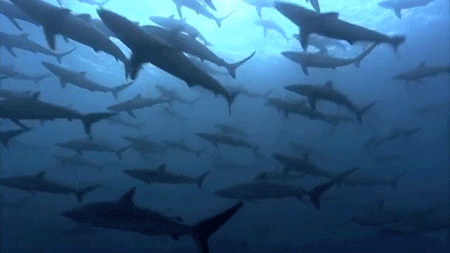
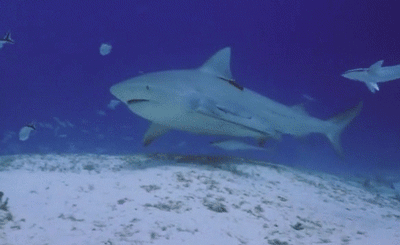
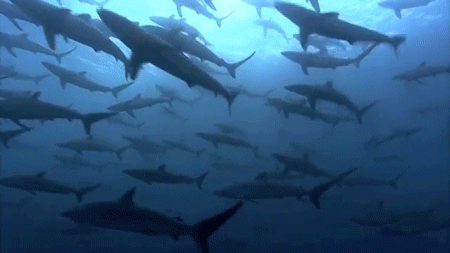
Why music might be killing sharks
For too long, sharks have been portrayed and perceived as the menacing, lurking creatures in the deep. Contrary to popular belief, we are much more of a threat to them than they are to us.
Researchers have found that the ominous music that often accompanies even documentary footage of them has inspired excessive fear about sharks.
In an experiment at UC San Diego, participants watched footage of sharks. Some scenes featured uplifting music, and others had a more daunting score.
The effect was what you might expect. Viewers saw sharks as intimidating creatures when they they also heard ominous music.
But with uplifting music (or none at all), viewers had a more positive impression of sharks.
This is problematic because rarely do we see shark footage without the ominous music, and the negative portrayals of sharks may be hindering conservation efforts.
“We know from prior research that conservation progress for sharks is sluggish compared to marine mammals and that this slow response may be due in part to the societal marginalization of sharks,” says study co-author Elizabeth Keenan.
After all, in the words of Senegalese conservationist Baba Diou, “we will conserve only what we love.”
And while they’re still not exactly a furry, cuddly rabbit, consider this: you’re more likely to be struck by lightening than fall prey to a fatal shark attack.

Australian researchers have investigated signs of geological structures hidden behind the Great Barrier Reef in Queensland, and have found a much deeper reef spanning more than 6,000 square kilometres (2,316 square miles).
New seafloor maps of the area have revealed a vast, underwater field of doughnut-shaped mounds, each one measuring 200 to 300 metres (656 to 984 feet) across, and some as much as 30 metres deep.
Scientists have seen hints of this enormous reef for over 30 years, but until now, haven’t had the chance to investigate it properly.
Fortunately, Royal Australian Navy aircraft fitted with LiDAR remote sensing technology have been flying over the area, and have finally mapped the shape, size, and vast scale of the deep reef.
“We’ve now mapped over 6,000 square kilometres. That’s three times the previously estimated size, spanning from the Torres Strait to just north of Port Douglas,” says one of the researchers, Mardi McNeil from Queensland University of Technology.
“They clearly form a significant inter-reef habitat which covers an area greater than the adjacent coral reefs.”
Continue Reading.

GUYS. The future is now.
A lot of people live in fear because they haven’t figured out how you’re going to react when faced with a certain set of circumstances. I’ve come to terms with this by looking deeply into whatever makes me fearful - what are the key elements that get the hairs up on the back of my neck - and then figuring out what I can do about it.
Chris Hadfield (via fyp-science)

“Space Train” Concept Could Get Humans to Mars in Two Days, If Only It Would Work

Report: A host of common chemicals endanger child brain development
In a new report, dozens of scientists, health practitioners and children’s health advocates are calling for renewed attention to the growing evidence that many common and widely available chemicals endanger neurodevelopment in fetuses and children of all ages.
The chemicals that are of most concern include lead and mercury; organophosphate pesticides used in agriculture and home gardens; phthalates, which are used in pharmaceuticals, plastics and personal care products; flame retardants known as polybrominated diphenyl ethers; and air pollutants produced by the combustion of wood and fossil fuels, said University of Illinois comparative biosciences professor Susan Schantz, one of dozens of individual signatories to the consensus statement.
Polychlorinated biphenyls, once used as coolants and lubricants in transformers and other electrical equipment, also are of concern. PCBs were banned in the U.S. in 1977, but can persist in the environment for decades, she said.
The new report, “Project TENDR: Targeting Environmental NeuroDevelopment Risks,” appears in the journal Environmental Health Perspectives. The group also has a website with information about each of the chemicals of concern.
“These chemicals are pervasive, not only in air and water, but in everyday consumer products that we use on our bodies and in our homes,” Schantz said. “Reducing exposures to toxic chemicals can be done, and is urgently needed to protect today’s and tomorrow’s children.”
Schantz is a faculty member in the College of Veterinary Medicine and in the Beckman Institute for Advanced Science and Technology at the U. of I.
“The human brain develops over a very long period of time, starting in gestation and continuing during childhood and even into early adulthood,” Schantz said. “But the biggest amount of growth occurs during prenatal development. The neurons are forming and migrating and maturing and differentiating. And if you disrupt this process, you’re likely to have permanent effects.”
Some of the chemicals of concern, such as phthalates and PBDEs, are known to interfere with normal hormone activity. For example, most pregnant women in the U.S. will test positive for exposure to phthalates and PBDEs, both of which disrupt thyroid hormone function.
“Thyroid hormone is involved in almost every aspect of brain development, from formation of the neurons to cell division, to the proper migration of cells and myelination of the axons after the cells are differentiated,” said Schantz. “It regulates many of the genes involved in nervous system development.”
Schantz and her colleagues at Illinois are studying infants and their mothers to determine whether prenatal exposure to phthalates and other endocrine disruptors leads to changes in the brain or behavior. This research, along with parallel studies in older children and animals, is a primary focus of the Children’s Environmental Health Research Center at Illinois, which Schantz directs.
Phthalates also interfere with steroid hormone activity. Studies link exposure to certain phthalates with attention deficits, lower IQ and conduct disorders in children.
“Phthalates are everywhere; they’re in all kinds of different products. We’re exposed to them every day,” Schantz said.
The report criticizes current regulatory lapses that allow chemicals to be introduced into people’s lives with little or no review of their effects on fetal and child health.
“For most chemicals, we have no idea what they’re doing to children’s neurodevelopment,” Schantz said. “They just haven’t been studied.
“And if it looks like something is a risk, we feel policymakers should be willing to make a decision that this or that chemical could be a bad actor and we need to stop its production or limit its use,” she said. “We shouldn’t have to wait 10 or 15 years – allowing countless children to be exposed to it in the meantime – until we’re positive it’s a bad actor.”

A fascinating new simulation finds that self-driving cars will terraform cities:90% of cars will be eliminated, acres of land will open up, and commute times will drop 10%. A team of transportation scientists at the Organization for Cooperation and Development took data on actual trips in Lisbon, Portugal and looked at how a fleet of self-driving, shared “taxibots” would change city landscape [PDF].
We need to move to large scale implementation as soon as the technology is good enough
Solar System: Things to Know This Week
Our solar system is huge, let us break it down for you. Here are a few things you should know this week:
1. Closeup of a King

For the first time since it entered orbit around Jupiter in July, our Juno spacecraft has flown close to the king of planets—this time with its eyes wide open. During the long, initial orbit, Juno mission managers spent time checking out the spacecraft “from stem to stern,” but the science instruments were turned off as a precaution. During this latest pass, Juno’s camera and other instruments were collecting data the whole time. Initial reports show that all went well, and the team has released a new close-up view that Juno captured of Jupiter’s north polar region. We can expect to see more close-up pictures of Jupiter and other data this week.
+Check in with Juno
2. Getting Ready to Rocket

Our OSIRIS-REx mission leaves Earth next week, the first leg of a journey that will take it out to an asteroid called Bennu. The mission will map the asteroid, study its properties in detail, then collect a physical sample to send back home to Earth. The ambitious endeavor is slated to start off on Sept. 8.
+See what it takes to prep for a deep space launch
3. New Moon Rising

The Lunar Reconnaissance Orbiter (LRO) has already mapped the entire surface of Earth’s moon in brilliant detail, but the mission isn’t over yet. Lunar explorers still have questions, and LRO is poised to help answer them.
+See what’s next for the mission
4. A Mock-Eclipse Now

We don’t have to wait until next year to see the moon cross in front of the sun. From its vantage point in deep space, our Solar Dynamics Observatory (SDO) sometimes sees just that. Such an event is expected on Sept. 1.
+See the latest sun pictures from SDO
5. Jupiter’s Cousins

Our galaxy is home to a bewildering variety of Jupiter-like worlds: hot ones, cold ones, giant versions of our own giant, pint-sized pretenders only half as big around. Astronomers say that in our galaxy alone, a billion or more such Jupiter-like worlds could be orbiting stars other than our sun. And we can use them to gain a better understanding of our solar system and our galactic environment, including the prospects for finding life.
Want to learn more? Read our full list of the 10 things to know this week about the solar system HERE.
Make sure to follow us on Tumblr for your regular dose of space: http://nasa.tumblr.com
Splish, Splash, Orion Takes a Bath
The Orion spacecraft is a capsule built to take humans farther than they’ve ever gone before, to deep space and eventually Mars. But before astronauts travel inside this new vehicle, we have to perform tests to ensure their safety.

One of these tests that we’ll talk about today simulates an ocean splashdown. Water impact testing helps us evaluate how Orion may behave when landing under its parachutes in different wind conditions and wave heights. The spacecraft has been undergoing a series of these tests at our Langley Research Center’s Hydro Impact Basin…which is our fancy way of saying pool.

The test capsule, coupled with the heat shield from Orion’s first spaceflight, swung like a pendulum into Langley’s 20-foot-deep basin on Aug. 25.

Inside the capsule were two test dummies – one representing a 105-pound woman and the other, a 220-pound man — each wearing spacesuits equipped with sensors. These sensors will provide critical data that will help us understand the forces crew members could experience when they splash down in the ocean.
This specific drop was the ninth in a series of 10 tests taking place at Langley’s Landing and Impact Research Facility. It was designed to simulate one of the Orion spacecraft’s most stressful landing scenarios, a case where one of the capsule’s three main parachutes fails to deploy. That would cause Orion to approach its planned water landing faster than normal and at an undesirable angle.
Under ideal conditions, the Orion capsule would slice into the water of the Pacific Ocean traveling about 17 miles per hour. This test had it hitting the pool at about 20 mph, and in a lateral orientation. Instead of being pushed down into their seats, astronauts in this scenario would splashdown to the side.
With this test’s success and one final drop in this series scheduled for mid-September, researchers have accumulated a lot of important information.
To find out more, visit nasa.gov or follow @nasaorion on Tumblr, Twitter and Facebook.
Make sure to follow us on Tumblr for your regular dose of space: http://nasa.tumblr.com

Astronomers have found a nearby galaxy that’s roughly the same mass as the Milky Way, but somehow contains less than 1 percent of its stars.
The galaxy is so dim, it’s evaded detention for decades, and now the team behind its discovery has figured out how its lack of stars hasn’t ripped it apart - it’s made from 99.99 percent dark matter.
Read more…

One thing we’re always doing as a species is expanding our knowledge of the heavens. We send out probes, robots, satellites, spacecraft, all to map out and add to our ever-expanding picture of what the Universe looks like.
But what if that picture suddenly became smaller? That is exactly what happened when new data from the Planck satellite tightened our previous notions of the observable universe, shrinking its area by 0.7%.
If you’ve never realized, we don’t actually see all of the stars in the Universe. If we did, night time sky would be a whole lot brighter. Instead, we see everything within a particular radius, the particle horizon. Any particle of light emitted outside that particle horizon is too far to have reached us.
So if we want to know just how large the observable universe is, we just have to figure out the distance between us and that particle horizon, right?
As it turns out, not quite.
The universe, specifically spacetime, is continuously expanding, with points in the universe moving further apart. This not only changes the distance between objects but also how fast light is moving in the universe.
The movement of spacetime has an effect on which photons reach us and can be observed.
So how do you calculate the radius? Back in 2003, scientists came up with an equation that took an event called “the recombination” as a reference point in the universe’s history. They combined that with the rate of the expansion of the universe and several other factors, in the end coming up with a number.
Back in 2003, that number was a radius of 45.66 billion light-years. Now, new data revealed a far more accurate number: 45.34 billion light-years.
“A difference of 320 million light-years might be peanuts on the cosmic scale, but it does make our knowable universe a little bit cozier,” Nick Tomasello from the University of the Sciences in Philadelphia writes over at Medium.
The study has been accepted for publication in an upcoming edition of Advances in Astrophysics.


